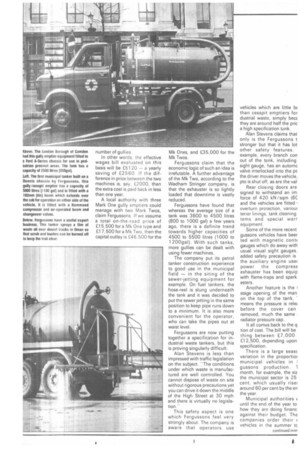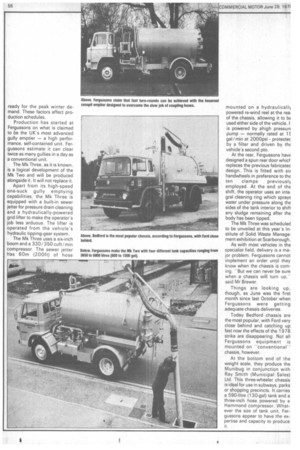Save more cash
Page 56

Page 57

Page 58

If you've noticed an error in this article please click here to report it so we can fix it.
at one big gulp Fergussons argue that municipal operators will do better to invest in higher capaci-y gully emptiers, Graham Montgomerie reports
"THE PROBLEM is convincing the local authorities to spend an extra £1500." That is how Alan Stevens, general manager of Fergussons (Tankers) Ltd, sums up the attitude of many councils when it comes to specifying municipal vehicles.
Mr Stevens contends that there is a distinct difference between going for a low first-cost machine and a low operatingcost version.
Fergussons (Tankers) Ltd are part of the Wadham Stringer Group building, as the company name suggests, tankers of all shapes and sizes from 2200 to 22000 litres (500 to 5000 gal). In the municipal field, the company specialises in gully and cesspit emptiers — either separately or dual-purpose.
I visited the Portsmouth base of Fergussons (Tankers) Ltd to talk to Alan Stevens and to Steve Brewer, his assistant sales manager, about the problems of the municipal market.
Currently, production at Fergussons is running at around one chassis per working day, or 300 per year. This includes all sorts of models ranging from industrial waste tankers and gully emptiers to petroleum tankers. Fergussons have been in the tanker business for 25 years, and now have extensive experience in the field of specialist bodywork.
Fergussons' selling philosophy is to get the operator to buy on the promise of low overall operating costs rather than by low first cost alone. They are now getting through.
Since local authority reorganisation, vehicles are being ordered by transport managers instead of other functional officers in many cases. The result is that operating cost is now receiving a higher priority.
Alan Stevens sums up the old buying policy in this way: "Our requirement for a gully emptieris X number of grids per day. What is the minimum specification which can do this?'' Mr Stevens claims that it is
possible to lower the cost per gully by going for a higher specification vehicle in the first place but he says that too many people are still "'capitalconscious rather than costconscious-. Fergussons tend to do well with authorities where transport engineers'run the fleet and less well with capitalconscious councils.
This argument between low first cost and low overall operating cost lies behind the development of the Fergussons Mk Two gully emptier. When the company started in the gully emptier business, everyone was producing more or less the same thing — around a four-inch boom and a 120 cm pump. This was all very well for removing debris like silt but very often bricks and cans were more than the four-inch boom could cope with.
Fergussons reasoned that a six-inch boom and a 350 cuft / min compressor would cope with the larger debris and allow a faster shift time.
The argument was then converted into one of cost as well as one of efficiency to provide a comparison between the "Mk One" type of gully emptier and the higher specification model. A gully emptier requires at least a one-man crew, some authorities have two, but for the purpose of the costing exercise, Fergussons were conservative and worked on a one-man operation.
Assuming, say, a £4.00 hourly rate for the operator and a five-day week, the total cost for the operation on a 48working-week year would be: 4.00 x 8 x 5 x 48 = £7680.
Fergussons' argument proceeds along the lines that if a man can clear 50 per cent more gullies in a given time, then he will only have to work two thirds of the year to clear the same number of gullies.
In other words, the effective wages bill evaluated on this basis will be £5120 — a yearly saving of £2560. If the difference in price between the two machines is, say, £2000, then the extra cost is paid back in less than one year.
A local authority with three Mark One gully emptiers could manage with two Mark Twos, claim Fergussons. If we assume a total on-the-road price of £15,500 for a Mk One type and £17,500 for a Mk Two, then the capital outlay is £46,500 for the
Mk Ones, and £35,000 for the Mk Twos.
Fergussons claim that the economic logic of such an idea is irrefutable. A further advantage of the Mk Two, according to the Wadham Stringer company, is that the exhauster is so lightly loaded that downtime is vastly reduced.
Fergussons have found that whereas the average size of a tank was 3600 to 4500 litres (800 to 1000 gal) a few years ago, there is a definite trend towards higher capacities of 4500 to 5500 litres (1000 to 1200gal). With such tanks, more gullies can be dealt with using fewer machines.
The company put its petrol tanker construction experience to good use in the municipal field — in the siting of the sewer-jetting equipment for example. On fuel tankers, the hose-reel is slung underneath the tank and it was decided to put the sewer jetting in the same position to keep pipe runs down to a minimum. It is also more convenient for the operator, who can take the pipes out at waist level.
Fergussons are now putting together a specification for industrial waste tankers, but this is proving singularly difficult.
Alan Stevens is less than impressed with traffic legislation on the subject. -The conditions under which waste is manufactured are well controlled. You cannot dispose of waste on site without rigorous precautions yet you can drive it down the middle of the High Street at 30 mph and there is virtually no legislation.'"
This safety aspect is one which Fergussons feel very strongly about. The company is aware that operators use vehicles which are little bf than cesspit emptiers for dustrial waste, simply becE they are around half the pric a high specification tank.
Alan Stevens claims that only is the Fergussons t stronger but that it has lot other safety features. example, every branch con out of the tank, including sight gauge, has an automc valve interlocked into the pt the driver moves the vehicle, pto is shut off, as are the va[ Rear closing doors are signed to withstand an im force of 420 10,1 fsgm (6C and the vehicles are fitted overturn protection, variow tenor linings, tank cleaning tems and special warr equipment.
Some of the more recent gussons vehicles have beer ted with magnetic contt gauges which do away with usual visual sight gauges. added safety precaution is the auxiliary engine uses power the compress exhauster has been equip with flame-traps and spark esters.
Another feature is the 1 stage opening of the man on the top of the tank. means the pressure is rele before the cover can removed, much the same radiator pressure cap.
It all comes back to the q tion of cost. The bill will be thing between £7,000 £12,500, depending upon specification.
There is a large seas( variation in the proportioi municipal vehicles in I gussons production. 1 month, for example, the siz the municipal sector is 25 cent, which usually rise! around 60 per cent by the en the year.
Municipal authorities until the end of the year to how they are doing financ against their budget. The companies order their vehicles in the summer tc ready for the peak winter demand. These factors affect production schedules.
Production has started at Fergussons on what is claimed to be the UK's most advanced gully emptier — a high performance, self-contained unit. Fergussons estimate it can clear twice as many gullies in a day as a conventional unit.
The Mk Three, as it is known, is a logical development of the Mk Two and will be produced alongside it. It will not replace it.
Apart from its high-speed one-suck gully emptying capabilities, the Mk Three is equipped with a built-in sewer jetter for pressure drain cleaning and a hydraulically-powered grid lifter to make the operator's job less arduous. The lifter is operated from the vehicle's hydraulic tipping-gear system.
The Mk Three uses a six-inch boom and a 330/ 350 cuft/ min compressor. The sewer jetter has 60m (200ft) of hose
mounted on a hydraulically powered re-wind reel at the real of the chassis, allowing it to bE used either side of the vehicle. I. is powered by ahigh pressurE pump — normally rated at 1 E gal/min at 2000psi protectec by a filter and driven by thE vehicle's second pto.
At the rear, Fergussons havE designed a spun rear door whictreplaces the previous fabricatec design. This is fitted with siti handwheels in preference to thE
ten clamps previously employed. At the end of thE shift, the operator uses an integral cleaning ring which sprays water under pressure along the sides of the tank interior to shift any sludge remaining after the body has been tipped.
The Mk Three was scheduled to be unveiled at this year's Institute of Solid Waste Management exhibition at Scarborough.
As with most vehicles in the specialist field, delivery is a major problem. Fergussons cannot implement an order until they know when the chassis is coming. 'But we can never be sure when a chassis will turn up,said Mr Brewer.
Things are looking up, though, as June was the first month since last October when Fergussons were getting adequate chassis deliveries.
Today Bedford chassis are the most popular, with Ford very close behind and catching up fast now the effects of the 1978 strike are disappearing. Not all Fergussons equipment is mounted on "conventional" chassis, however.
At the bottom end of the weight scale, they produce the Munibug in conjunction with Ray Smith (Municipal Sales) Ltd. This three-wheeler chassis is ideal for use in subways, parks or shopping precincts. It carries a 590-litre (130-gal) tank and a three-inch hose powered by a Hammond compressor. Whatever the size of tank unit, Fergussons appear to have the expertise and capacity to produce it.
































































































































